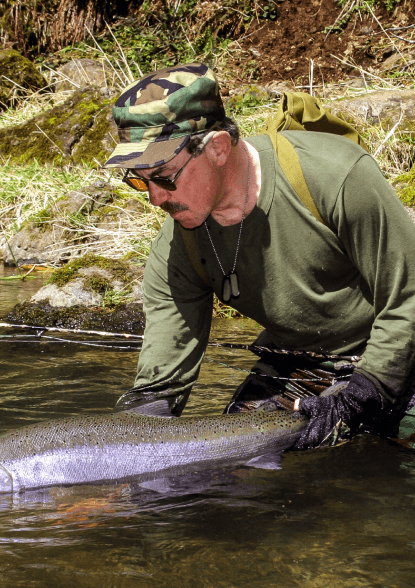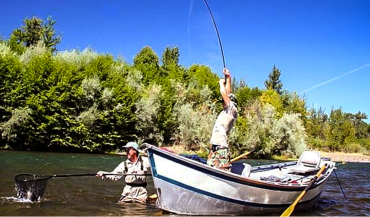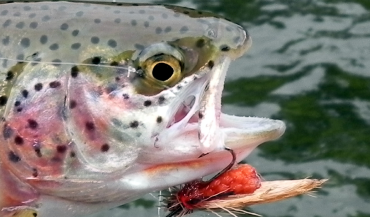Effective Stream Trout Fly Fishing Techniques
There are three general trout fly fishing techniques. A successful fly angler must be knowledgeable and practiced in all three methods to consistently catch fish.
Just as there are three fly fishing techniques—dry fly fishing, wet fly fishing, and nymph fishing—flies are most simply divided into three general groupings: dry flies, wet flies, and nymphs.
Dry flies are meant to imitate adult aquatic or terrestrial insects floating on the water’s surface. Wet flies represent such things as swimming or emerging aquatic insects, smaller fish, crayfish, leeches, and scuds (“freshwater shrimp”). These are fished in the water column from just subsurface to near the stream bottom, a wide range of depths. Lastly, nymphs imitate immature aquatic insects living in, on, or near the stream bottom.
The Beginner’s Trap
If given a choice I suspect that 99% of all fly fishers would choose dry fly fishing as the single technique that holds the most pleasure and satisfaction for them. Watching your dry fly drift on the currents when suddenly a trout pierces the surface to inhale it is always exciting and memorable. These are the most dramatic moments in fly fishing, an unmatched visual fishing pleasure.
What I am leading up to here is the alluring trap into which fly anglers — especially beginners — may fall when it comes to fishing the dry fly. I, too, fell under the Sirens’ Song.
Here’s the familiar story. The determined fly fishing beginner acquires some good equipment, reads a book or two, learns the rudiments of an adequate casting stroke, and eventually finds a few good places to fish. Most fly fishing beginners I encounter are familiar with dry flies, so that is where they start. It is clearly understood to them that a fish is interested in their fly when they can actually watch the trout take it. Confirmation and positive reinforcement are received. And, a little success goes a very long way in embedding dry fly fishing behavior in the angler’s psyche. Successfully fooling a trout on a dry fly is pleasurable. More pleasure is, therefore, sought. Just like the rat pressing the food-release bar in its cage, more casts are made until another rising trout is caught. The dry fly habit is being reinforced.
All this being said, let’s consider dry fly fishing, both a standard/classic presentation and an effective variation which I often employ to catch trout willing to look to the surface and grab my floating fly.
Dry Fly Presentations
The standard, classic presentation of the dry fly begins with a cast that is angled upstream, somewhere between 45 degrees and straight into the current. The goal here is to drift the fly naturally on the surface, without movement. As the fly drifts back to you, the line and leader will eventually pull on the fly causing it to drag or be pulled under the water. Action must be taken to counteract this drag.
“Mending” the line and leader is crucial to maintaining a natural dead-drift of the floating fly. A mend is a repositioning of the line and leader. After the fly has drifted for a count of 4 after the cast, the mend starts with lifting the rod tip higher than your head, with the tip positioned to the downstream side of your body. The rod tip is swept upstream in a motion similar to turning a jump rope: start with the tip high, then finish low to your upstream side. To view the mechanics of what I am describing, check out my YouTube videos on mending, Parts 1 and 2. Search “Mending — Michael Gorman”. Let me reiterate: mending is critical to the dead-drift dry fly presentation.
A dead-drift presentation can also be achieved without a mend: cast the fly across or down-and-across the current direction. Just before the line settles on the water, thrust the rod tip in the upstream direction. Then, follow the drift of the line downstream with the rod. That is, move your rod tip downstream as the line drifts downstream so as not to tighten on the line and retard the natural float of the fly.
An Effective Presentation Variation
Some aquatic insects are very active when the hatch and start floating down the river. Caddisflies are one example of insects which flit, flop, and skitter on the water rather than sit quietly. The trout that would eat these bugs recognize this behavior and are best fooled by the fisherman whose flies imitate this movement. It starts with presenting the fly downstream at 45 degrees. Keep the line tight and allow the fly to skate, waking on the surface. Add an occasional twitch to the skate. You may be pleasantly surprise.
The Parachute Adams and Stimulator (pictured left) are two excellent dry flies. I carry the Adams is sizes 14 – 18, and the Stimulator, a buoyant skater, in sizes 10 – 14. Olive, orange and yellow are productive Stimulator colors. Use a 9’ leader with the tippet diameter matched to the fly size.
There WILL be those days where the fish will eat floating insects with abandon and the dry fly angler will dwell a spell in Nirvana. But, problems arise (pun intended) when the rise to the dry fly does not happen on a very consistent basis throughout the fishing year. Most of a typical fishing day finds few, if any, fish striking surface flies. The one-dimensional dry flyist will be disappointed, even discouraged. The moral: learn and practice other fly fishing techniques. For on-the-water instruction on all three fly fishing methods, book a guided day on the McKenzie or Santiam River. Learn about and practice effective fly fishing techniques that catch fish.



